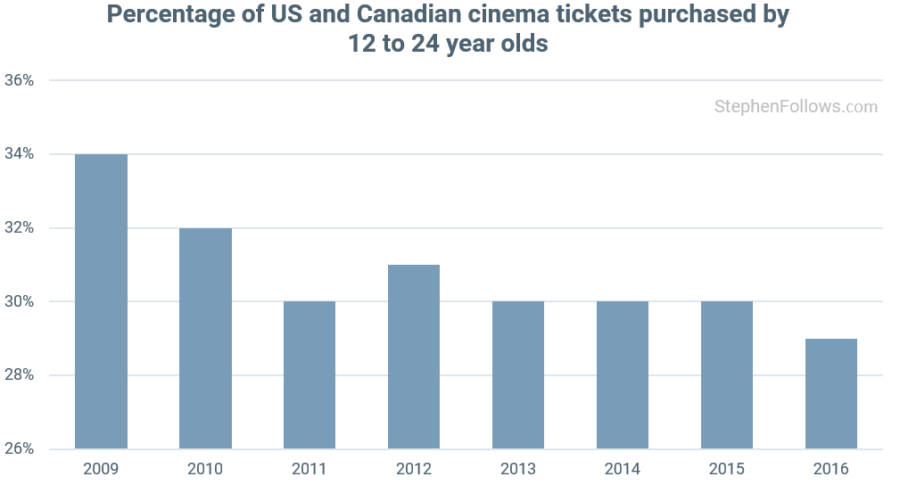How do movie genre tastes change with age?

Today's article is a response to a comment posted on an article I wrote last year entitled What films are older cinemagoers watching? Jonathan asked which movies audiences aged 18-24 years old, 25-34 years old and 35-44 years old watch.
By combing UK box office receipts and cinema exit polls, we can get a sense of how movie tastes differ by age. There are some notes at the bottom of this article which are worth reading if you want to know more about the data.
Let's start with the big picture...
Who goes to the cinema?
The original article focused on what movies the oldest segment of the UK cinema-going audience chooses to watch. For slightly myopic reasons, the film industry's demographic banding has historically labelled everybody older than 44 years old as being in the oldest age bracket. In recent years, they have split this into "45-54" and "55+" but one could argue that this is still a very broad group.
This older audience is growing, so it may seem strange that the cinema industry regards those aged over 45 or 55 as the 'oldest people'. The reason for this categorisation is that cinema has been primarily a young persons' pursuit since the big decline in general attendance which began in the late 1940s.
The chart below compares the UK population with UK cinema box office receipts. We can see that while people 45 and older make up almost half of the UK population, they account for only a fifth of the cinema audience.

How genre interest changes with age
Let's narrow in on the genre choices of each group and see how audience preferences change as we move up the age brackets. The following charts use exit poll data and box office receipts to show how much of the money each age group spends on seeing that genre. For example, 12.3% of the money spent by people aged 15 to 24 in cinemas is spent on Romance movies.
I've grouped each of the ten major genres by the general pattern we see across the six age groups. The first group are movies which peak very young.
Unsurprisingly, family films and animations make up a significant proportion of the money spent by (or on behalf of) children. These decline quicker as we look at teenagers and very young adults but rise again when we start looking at those aged between 35 and 44. This is what a trip to the cinema looks like for parents.

Next, another couple of genres that decline with age - comedy and adventure movies.

And films which children are generally barred from seeing, and so peak with teenagers - crime and horror movies. 54% of all the money grossed by horror movies theatrically is from audience members aged between 15 and 24 years old.

In case you're wondering which crime films children are watching, as per the charts above, consider that both Muppets Most Wanted and The Pink Panther have crime and theft as major elements of their plot. The small number of horror admissions for those under 15 years old are down to a handful of horror movies with a 12 or 12A rating in the UK, such as The Others.
The penultimate group are action-packed genres in which interest grows and then declines with age. Both action and sci-fi movies are enjoyed most by young adults and least by the very oldest and youngest audience members.

Finally, we come to two genres which grow as we move up the age brackets - drama and romance. Both are disproportionately enjoyed by the oldest age groups, those 45 years and older.

Notes
The data for today's piece came from Pearl and Dean's public microsite, comScore, IMDb and the Office of National Statistics. It focuses on films released between 2005 and 2015, inclusive.
Movies were permitted to have up to three genres, and I used IMDb's genre classification system. This explains why the overall choices of any age group add up to more than 100%. For example, Alien Vs Predator is not only a bad action movie but also a bad horror movie and a bad sci-fi movie.
The Pearl and Dean exit poll data is designed to help cinema advertisers and it does not cover all movies, meaning that there will be a slight bias towards the bigger, advertiser-friendly movies. That said, in this article I'm looking at the overall UK cinema population and the majority of those tickets are bought for the major movies (an average of 75% of the box office goes to the 50 highest grossing films each year). Therefore, if your focus is independent or art-house cinema then you may find that your audience skews older.
The chart comparing UK population and cinema receipts requires some nit-picky detail to ensure we all understand exactly what it's showing. The UK population data is from the Office of National Statistics in 2014 and shows what percentage of the UK population aged over six years old falls into each of the six categories. I excluded everybody aged six and under because we don't have cinema data for that age group and I wanted to compare like with like. The cinema data is a calculation based on exit polls and the total box office income.
Epilogue
I mentioned the ageing cinema population briefly towards the top of the article. If you want to know more then you may be interested in another article from last year, entitled Are fewer young people watching movies in cinemas?
To whet your appetite, here is just one chart from that article showing the overall trend.



